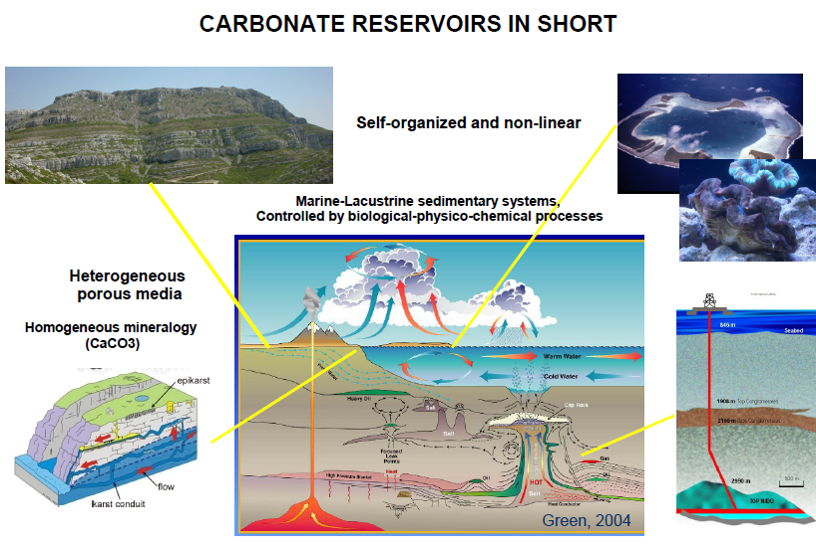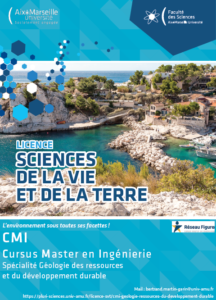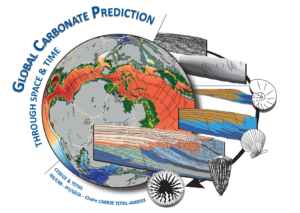TOTAL-AMIDEX
INDUSTRIAL CHAIR
CARBONATE GEOSCIENCES: ENERGY, ENVIRONMENT, EDUCATION
Ca3E
Pr. Jean Borgomano
AIX-MARSEILLE UNIVERSITE – OSU PYTHEAS – CEREGE
Understand and predict carbonate reservoirs in the context of the energy transition and global changes.
Scientific, industrial and societal context
Carbonate sedimentary systems, like modern coral reefs, belong to Earth external envelopes and form a unique interface between biosphere, hydrosphere, atmosphere and lithosphere that is in permanent physico-chemical disequilibrium. They consist in solid substratum, mobile or rigid, acting as a major carbon sink, with complex structures and heterogeneities at all scales. Understanding carbonate sedimentary systems consists in fact to study exceptional archives of the Earth System, from Precambrian to present day, including evolution of life, climate and sea level changes. The particular spatial relationships between organic and mineral carbon cycles in the context of global-regional geodynamic and climatic changes have resulted in the preservation of more than 70 % of the global volume of conventional hydrocarbon in carbonate rocks. Managing and securing these important energy resources is becoming critical to support the forthcoming energy transition, but remaining reserves in these complex reservoirs are difficult to detect and predict. Future exploration and production of hydrocarbon from carbonate reservoirs, that would not rely any longer on massive industrial investments, will subsequently become increasingly risky from economical and technological view points. Paradoxically, a successful energy transition will require drastic improvements of our knowledge on carbonates to guaranty an economic hydrocarbon supply. Such developments in carbonate reservoir geosciences will also contribute to address alternative energy challenges, like geothermal energy, thermal storage and co-generation, and critical issues such as water resources, especially in karst systems and CO2 sequestration. Improving geomodels from the past carbonate records will directly impact on our capacity to monitor and predict the evolution of modern coastal carbonate environments (coral reefs, atolls and islands) submitted to global climate changes (ie. sea level rise, ocean acidity…).
General objectives
The philosophy of the chair is to develop international geoscience research and education programs to improve our understanding in carbonate systems and reservoirs within the context of energy transition and global changes. Four types of activities will be associated to the chair position:
- Develop new concepts and models for improving exploration and production of hydrocarbon in Carbonate Reservoirs by setting-up major and game-changer international research projects.
- Develop knowledge and technological exchange between petroleum geosciences and environment geosciences in the domain of Carbonate Reservoirs (CO2 sequestration, water resources, geothermy,…) and global climate changes (monitoring coastal carbonates), by setting-up original RD and education programs.
- Create innovative international Master-level curriculum in Carbonate Geosciences spanning from energy to environment geosciences.
- Provide scientific expertise and training to TOTAL Exploration-Production in Carbonate Reservoir Geosciences
General scientific scope
- Filling a critical scientific gap in EP Carbonate Geosciences by building a generalized carbonate prediction model, with a process-based approach, coherent at global, regional and local reservoir scales and coupled to paleo-oceanographic/climatic and geodynamic models.
- Prediction of carbonate reservoir properties, heterogenities and flow units by integrating innovative geological, geochemical, geophysical, fluid dynamic and numerical modeling approaches.
- Support the development of new methods for normalizing risk/uncertainty assessment of Carbonate Reservoirs at exploration-to-production scale.
- Implement new methodologies in Carbonate Geosciences based on technological and scientific exchanges from Petroleum Geosciences to Environment Geosciences in cooperation with regional industrial and international scientific networks
- Take the role of “focal-point” for all the RD projects between TOTAL and CEREGE. This role should facilitate the general relationships between the two partners (administration, communication, students, networking, …), provide an overview and general synthesis of on-going projects and organize annual meeting.
Key general scientific problematics sustain this carbonate research program. Understanding the strong concentration of hydrocarbon resources (hosted in carbonate reservoirs) in particular age intervals and geographical locations requires the characterization and modeling of first order processes that controls the distribution of at global-regional scale of carbonate reservoirs and source rocks throughout the Phanerozoic (time & space): the evolution of carbonate ecosystems (carbonate factories) and the production/preservation of organic matter, in relation with paleo-climate/oceanography and geodynamic controlling factors. The principle of “actualism”, inspired from modern marine carbonates (ie. climatic zonation) needs to be questioned. How the different carbonate-producing systems (biotic or abiotic), so called “carbonate factories” respond to global (ie. Eustasy, climate, CO2, O2,…) and local (ie. subsidence, oceanography,…) parameters for building carbonate stratigraphic architectures is critical to predict carbonate reservoirs and flow behaviours. In this context, the combination of carbonate sequence stratigraphic concepts, not taking into account carbonate factories (ie. considering only a linear relationship between accommodation and carbonate production), and standard carbonate sedimentary profiles (ie. reef, platform) inspired from modern environments, needs to be challenged. The same question applies to carbonate diagenetic models, addressing rock-fluid interaction in the shallow lithosphere, that are strongly inspired from modern diagenetic carbonate environments. Absolute dating of carbonate cements by the U/Pb isotope method coupled to laser ablation of cement (Annexe 4) is expected to produce drastic changes in current diagenetic and reservoir models. Can we establish and quantify the links between carbonate reservoir architectures, carbonate factory and global changes during the Phanerozoic? Answering this question will increase the coherency between global and reservoir carbonate models and improve prediction of carbonate reservoir at all scales and for all application purposes.




